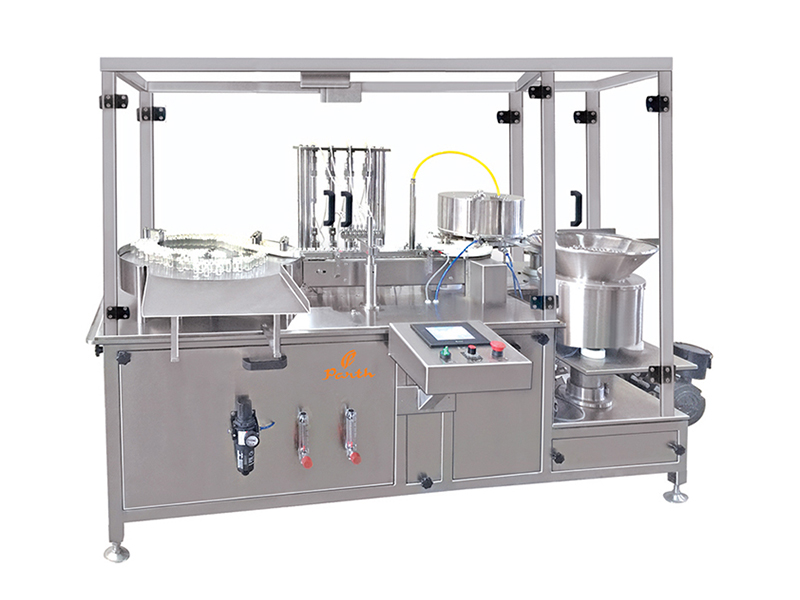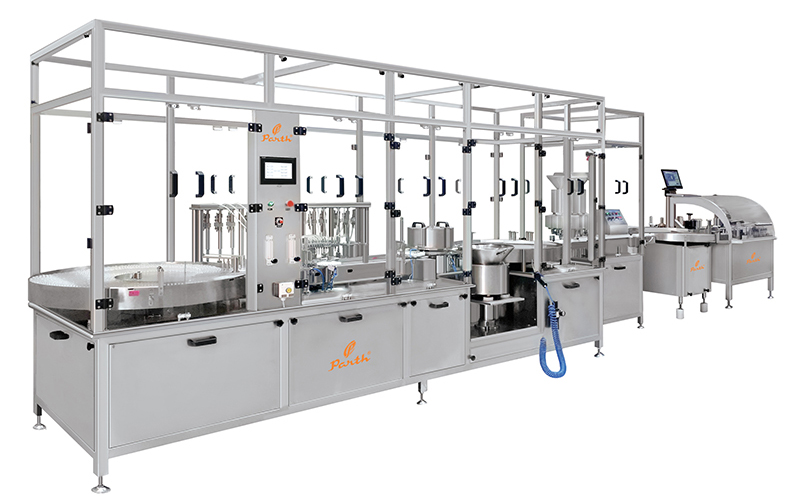In pharmaceutical production, consistent fill levels are essential - especially when dealing with injectable medications, where precision is not only expected but demanded. The evolution of liquid vial filling machines has progressed from basic volume-based dosing to highly responsive, motion-synchronized systems. This transformation is largely due to the rise of dynamic filling technology, a mechanism that ensures each vial is filled with uniform volume, regardless of vial shape, size or speed of the production line.
Unlike traditional fill-and-stop systems, dynamic filling works while both the filling nozzle and vials are in motion. The result? Seamless, high-speed, high-accuracy dosing. This article focuses on how this advanced technology functions within liquid vial filling & stoppering machines and why it’s becoming the gold standard in injectable filling.
What is Dynamic Filling Technology?
At its core, dynamic filling involves synchronized motion between the vial and filling nozzle. In a conventional setup, vials pause momentarily under the nozzle while filling occurs. This start-stop operation can cause minor inaccuracies, especially at high speeds or with foaming liquids.
Dynamic filling removes this bottleneck by allowing continuous movement. The nozzle travels in parallel with the vial, maintaining a precise distance and alignment throughout the filling phase. As both the vial and nozzle move in harmony, filling is executed without interruption or turbulence.
This is particularly effective in modern injectable liquid vial filling machines, where the goal is not only speed but minimal variability in fill volume.
Key Advantages of Dynamic Motion in Liquid Filling Lines
Consistency at Scale
Whether you're filling 5,000 vials an hour or 50,000, consistency is critical. Dynamic systems ensure:
- Uniform fill levels across all vials.
- No impact from minor differences in vial dimensions.
- Real-time adjustments based on flow rate and motion detection.
This results in reduced product waste, lower reject rates and enhanced process reliability.
Smooth Handling of Challenging Liquids
Injectables often include solutions that are viscous, protein-based or foam-prone. Dynamic filling allows:
- Controlled nozzle movement to reduce splash and foaming.
- Optimized fill speed tailored to fluid characteristics.
- Gentle dosing that preserves the chemical integrity of sensitive compounds.

Reduced Cycle Time
By filling vials on the move, production speeds increase significantly. There is no need to halt the line for each dose, which allows continuous throughput - particularly valuable for high-capacity liquid vial filling lines.
Compatibility with Various Vial Size
Because dynamic motion tracks vial positioning in real-time, changes in vial diameter or height can be managed without major hardware overhauls. This is ideal for contract manufacturers handling different formats or batch types.
Seamless Integration with Stoppering Systems
In integrated liquid vial filling and stoppering machines, dynamic filling technology works hand-in-hand with advanced stoppering mechanisms. After the precise fill is complete:
- Vials move directly to the stoppering unit.
- Stopper placement is executed with equal precision, often using servo-controlled arms.
- Consistent fill height ensures the stopper fits without displacing the liquid or creating pressure variations.
This eliminates inconsistencies that can arise when over- or under-filled vials are stoppered incorrectly, ensuring better closure and longer shelf life.
Key Features of Dynamic Motion-Based Machines
From an engineering standpoint, here’s what defines a dynamic liquid vial filling machine:
- Servo-Driven Nozzles: These track and match vial movement in real-time.
- Programmable Motion Control: Allows users to customize fill speed, nozzle path and volume per batch.
- Nozzle Dive Control: Prevents dripping and enables diving to optimal depth based on vial geometry.
- Vacuum-Assisted Stoppering: Integrated units apply stoppers while maintaining fill level and minimizing agitation.

Each of these elements works in harmony to produce a tightly controlled, highly automated process.
Injectable Liquid Vial Filling & Stoppering Machine
To better understand how dynamic filling is implemented in real-world equipment, consider the features of a top-tier injectable liquid vial filling & stoppering machine:
- Dynamic Motion Filling: Designed to keep pace with vial movement, ensuring identical fill levels in every unit. Even when vial shapes vary slightly, fill consistency is preserved.
- Seamless Stoppering System: Incorporates synchronized mechanisms that accurately place stoppers directly after filling, reducing the chance of contamination or seal failure.
- Easy Maintenance: Built with operator-friendly designs - parts are easy to access, clean and reassemble. This supports fast turnaround and minimal downtime.
- User Interface & Control: Equipped with advanced HMIs that allow operators to adjust parameters, store batch settings and monitor production in real time.
These features combine to support a production environment where precision, speed and reliability are paramount.
Practical Implications for Pharmaceutical Production
Integrating dynamic filling into a liquid filling line brings measurable improvements to operations:
- Less Downtime: Continuous operation reduces stop-start cycles and mechanical wear.
- Greater Flexibility: A single machine can adapt to multiple vial sizes and fill volumes with minimal changeover.
- Improved Yield: Accurate dosing means fewer rejections and better batch efficiency.
- Lower Operational Costs: Faster filling combined with reduced waste means better ROI over the machine’s lifetime.
It also allows for more consistent quality in products destined for global markets, where visual uniformity and dosing precision play a role in regulatory acceptance and consumer trust.
Why Choose Dynamic Over Traditional Filling Systems?
While traditional linear or volumetric fillers still serve many needs, they fall short when speed and precision must coexist. Dynamic systems excel because they:
- Eliminate inconsistencies caused by mechanical vibration or pause-fill mechanics.
- Reduce fluid turbulence, a key issue in delicate formulations.
- Enable high-speed production without sacrificing quality.
For pharmaceutical producers preparing for larger batch sizes or operating in sterile environments, dynamic motion offers an efficient, long-term solution.
Conclusion
The success of a liquid vial filling machine is no longer just about how fast it can dose liquid - it’s about how accurately, consistently and efficiently it can perform that task over time. Dynamic filling technology introduces a transformative approach where each vial receives a uniform fill, regardless of external variables.
As pharmaceutical demands evolve and injectable drugs become more complex, production systems must also advance. The integration of dynamic motion into injectable liquid vial filling & stoppering machines represents that evolution - where engineering meets precision and consistency becomes the standard.
FAQs About Liquid Vial Filling Machines
Dynamic filling technology allows synchronized motion between the vial and filling nozzle, ensuring precise, uninterrupted dosing without turbulence or inaccuracies.
By maintaining real-time synchronization between vial movement and the nozzle, dynamic filling ensures uniform fill levels, even with varying vial shapes and sizes.
Dynamic filling reduces splash and foam generation, providing optimized fill speed and gentle dosing for viscous or foam-prone injectable liquids.










